Which THREE of the following methods of business valuation would give a valuation of the equity of an entity, rather than the value of the whole entity?
A listed company is financed by debt and equity.
If it increases the proportion of debt in its capital structure it would be in danger of breaching a debt covenant imposed by one of its lenders.
Â
The following data is relevant:
 Â
 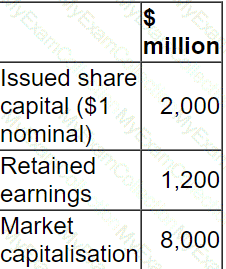
The company now requires $800 million additional funding for a major expansion programme.Â
Â
Which of the following is the most appropriate as a source of finance for this expansion programme?
A private company manufactures goods for export, the goods are priced in foreign currency B$. Â
The company is partly owned by members of the founding family and partly by a venture capitalist who is helping to grow the business rapidly in preparation for a planned listing in three years' time. Â
The company therefore has significant long term exposure to the B$.Â
This exposure is hedged up to 24 months into the future based on highly probable forecast future revenue streams. Â
The company does not apply hedge accounting and this has led to high volatility in reported earnings.Â
Â
Which of the following best explains why external consultants have recently advised the company to apply hedge accounting?
Company J plans to acquire Company K, an unlisted company whose equity is to be valued using a P/E ratio approach.Â
A listed company has been identified which is very similar to Company K and which can be used as a proxy.
However, the growth prospects of Company K are higher than those of the proxy.
The Directors of Company J are aware that certain adjustments will be necessary to the proxy company's P/E ratio in order to obtain a more reliable valuation. Â
Â
The following adjustments have been agreed:
   • 20% due to Company K being unlisted.
   • 15% to allow for the growth rate difference.
The total adjustment to the proxy p/e ratio is:
For which THREE of the following risk categories does IFRS 7 require sensitivity analysis?Â
A company is considering hedging the interest rate risk on a 3-year floating rate borrowing linked to the 12-month risk-free rate.
If the 12-month risk-free rate for the next three years is 2%, 3% and 4%, which of the following alternatives would result in the lowest average finance cost for the company over the three years?
A company is currently all-equity financed.
The directors are planning to raise long term debt to finance a new project.
The debt:equity ratio after the bond issue would be 30:60 based on estimated market values.
Â
According to Modigliani and Miller's Theory of Capital Structure without tax, the company's cost of equity would:
A company is considering whether to lease or buy an asset.
The following data applies:
   • The bank will charge interest at 7.14% per annum
   • The asset will cost $1 million
   • Tax-allowable depreciation is available on a straight line basis over 5 years
   • There is no residual value
   • Corporate tax is paid at 30% in the year when the profit is earned
What is the NPV of the buy option?
Â
Give your answer to the nearest $000.
Â
$Â ? Â
Company T is a listed company in the retail sector.
Its current profit before interest and taxation is $5 million.
This level of profit is forecast to be maintainable in future.
Company T has a 10% corporate bond in issue with a nominal value of $10 million.
This currently trades at 90% of its nominal value.
Corporate tax is paid at 20%.
Â
The following information is available:
 Â
 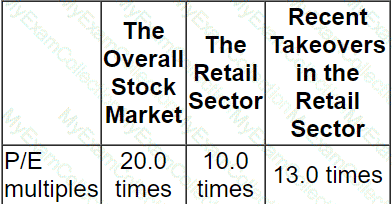
Which of the following is a reasonable expectation of the equity value in the event of an attempted takeover?
Company Z has identified four potential acquisition targets: companies A, B, C and D. Â
Company Z has a current equity market value of $580 million.
The price it would have to pay for the equity of each company is as follows: Â
  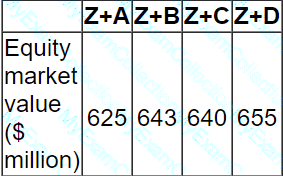
Only one of the target companies can be acquired and the consideration will be paid in cash.
The following estimations of the new combined value of Company Z have been prepared for each acquisition before deduction of the cash consideration:
 Â
Â
Ignoring any premium paid on acquisition, which acquisition should the directors pursue?
A company is considering the issue of a convertible bond compared to a straight bond issue (non-convertible bond).
Director A is concerned that issuing a convertible bond will upset the shareholders for the following reasons:
   • it will dilute their control
   • the interest payments will be higher therefore reducing liquidity
   • it will increase the gearing ratio therefore increasing financial risk
Director B disagrees, and is preparing a board paper to promote the issue of the convertible bond rather than a non-convertible.
Â
Advise the Director B which THREE of the following statements should be included in his board paper to promote the issue of the convertible bond?
The Board of Directors of Company T is considering a rights issue to fund a new investment opportunity which has a zero NPV.
Â
The Board of Directors wishes to explain to shareholders what the theoretical impact on their wealth will be as a result of different possible actions during the rights issue.
Â
Which THREE of the following statements in respect of theoretical shareholder wealth are true?
A venture capitalist invests in a company by means of buying:
   • 9 million shares for $2 a share and
   • 8% bonds with a nominal value of $2 million, repayable at par in 3 years' time.Â
The venture capitalist expects a return on the equity portion of the investment of at least 20% a year on a compound basis over the first 3 years of the investment.
Â
The company has 10 million shares in issue.
Â
What is the minimum total equity value for the company in 3 years' time required to satisify the venture capitalist's expected return?
Â
Give your answer to the nearest $ million.
Â
$Â Â million. Â Â
Â
G purchased a put option that grants the right to cap the interest on a loan at 10.0%. Simultaneously, G sold a call option that grants the holder the benefits of any decrease if interest rates fall below 8.5%.
Which THREE possible explanations would be consistent with G's behavior?
Company A has a cash surplus.
The discount rate used for a typical project is the company's weighted average cost of capital of 10%.
No investment projects will be available for at least 2 years.
Â
Which of the following is currently most likely to increase shareholder wealth in respect of the surplus cash?
On 1 January 20X1 a company entered into a S200 million interest rate swap with a bank at a fixed rate of 4% against the 6-month risk-free rate to hedge the interest rale risk on a floating rate borrowing.
6-month risk-free rate was as follows:

What is the net settlement due under the swap contract on 1 July 20X1?
An unlisted company operates in a niche market, exploring the west coast of Africa for new oiI reservoirs.
The oil exploration program has been successful in recent years and t now has a substantial amount of oil reserves with a high level of certainty of being recoverable Under financial reporting regulations, oil still in the ground is not recognised as an asset unit is extracted.
The expense of the exploration program has used up all the company’s available cash resources.
The company has denied to list or a stock market and raise finds through an initial public offering to finance its drilling program.
Which of the following valuation methods in the appropriate to use in calculating an initial listing price for this company?
Company A has agreed to buy all the share capital of Company B.
The Board of Directors of Company A believes that the post-acquisition value of the expanded business can be computed using the "boot-strapping" concept.
Which of the following most accurately describes "boot-strapping" in this context?
A company has a loss-making division that it has decided to divest in order to raise cash for other parts of the business.
The losses stem from a combination of a lack of capital investment and poor divisional management.
The loss-making division would require new capital investment of at least $20 million in order to replace worn out and obsolete assets.
If this investment was carried out, the present value of the future cashflows, excluding the investment expenditure, is expected to be $15 million.
Â
Which TWO of the following divestment methods are most likely to be suitable for the company?
The ex div share price of a company's shares is $2.20.
Â
An investor in the company currently holds 1,000 shares.
Â
The company plans to issue a scrip dividend of 1 new share for every 10 shares currently held.
Â
After the scrip dividend, what will be the total wealth of the shareholder?
Â
Give your answer to the nearest whole $.
Â
 $ ?  .
In the context of the Integrated Reporting
A listed publishing company owns a subsidiary company whose business activity is training.
It wishes to dispose of the subsidiary company.
Â
The following information is available:
  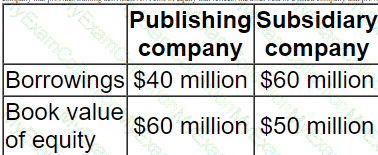
The board of the publishing company believe that the value of the subsidiary company, and hence the value of the equity invested in it, can be determined by calculating the present value of the subsidiary's free cashflows.
Â
Which of the following is the most appropriate discount rate to use when determining the enterprise value of the company?
It is now 1 January 20X0.
Company V, a private equity company, is considering the acquisition of 40% of the equity of Company A for a total amount of $15 million.
Company A has been established to develop a new type of engine which will be launched at the end of 20X1. Company A is forecasting that the new engine will result in free cash flows to equity of $2m in its first year of operation and that this will rise by 8% per year for the foreseeable future.
The new engine is the only commercial activity that Company A is involved in.
Company V intends to sell its stake in Company A when the new engine is launched.
Company A has a cost of equity of 12%.
Assuming that Company V receives an amount that reflects the present value of their shares in company A. what is the estimated annual rate of return to Company V from this investment? (To the nearest %)
Delta and Kappa both wish to borrow $50m.
Delta can borrow at a fixed rate of 12% or at a floating rate of the risk-free rate +3%
Kappa can borrow at 15% fixed or the risk-free rate +4%.
Delta wishes a variable rate loan and Kappa a fixed rate loan The bank for the two companies suggests a swap arrangement The two companies agree to a swap arrangement, sharing savings equally
What is the effective swap rate for each company?
A company wishes to raise new finance using a rights issue. The following data applies:
   • There are 20 million shares in issue with a market value of $6 each
   • The terms of the rights will be 1 new share for 4 existing shares held
   • After the rights issue, the theoretical ex-rights price (TERP) will be $5.75
Assuming all shareholders take up their rights, how much new finance will be raised ?
Â
Give your answer to one decimal place.
Â
$ Â ? Â million
Holding cash in excess of business requirements rather than returning the cash to shareholders is most likely to result in lower:
X exports goods to customers in a number of small countries Asia. At present, X invoices customers in X's home currency.
The Sales Director has proposed that X should begin to invoice in the customers currency, and the Treasurers considering the implications of the proposal.
Which TWO of the following statement are correct?
A company is planning a new share issue.
The funds raised will be used to repay debt on which it is currently paying a high interest rate.
Operating profit and dividends are expected to remain unchanged in the near future.
If the share issue is implemented, which THREE of the following are most likely to increase?
A company plans to acquire new machinery.
It has two financing options; buy outright using a bank loan, or a finance lease.
Â
Which of the following is an advantage of a finance lease compared with a bank loan?
A company wishes to raise additional debt finance and is assessing the impact this will have on key ratios.Â
The following data currently applies:
   • Profit before interest and tax for the current year is $500,000
   • Long term debt of $300,000 at a fixed interest rate of 5%
   • 250,000 shares in issue with a share price of $8
The company plans to borrow an additional $200,000 on the first day of the year to invest in new project which will improve annual profit before interest and tax by $24,000.
The additional debt would carry an interest rate of 3%.
Assume the number of shares in issue remain constant but the share price will increase to $8.50 after the investment.
The rate of corporate income tax is 30%.
Â
After the investment, which of the following statements is correct?
Using the CAPM, the expected return for a company is 10%. The market return is 7% and the risk free rate is 1%.
 What does the beta factor used in this calculation indicate about the risk of the company?
Company XXY operates in country X with the X$ as its currency. It is looking to acquire company ZZY which operates in country Z with the Z$ as its currency.
The assistant accountant at Company XXY has started to prepare an initial valuation of Company ZZY's equity for the first 3 years, however their valuation is incomplete. TBC' in the table below indicates that her calculations have yet to be completed.
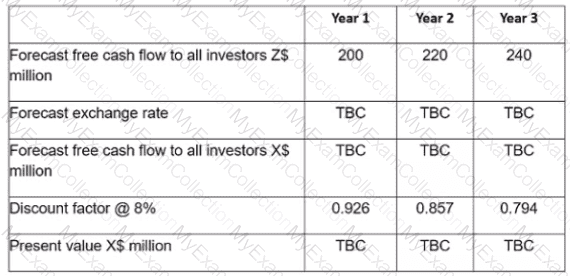
The following information is relevant:

What is the correct figure (to the nearest million S) to include in year 3 as the present value in X$ million?
A company's gearing is well below its optimal level and therefore it is considering implementing a share re-purchase programme.
This programme will be funded from the proceeds of a planned new long-term bond issue.
Its financial projections show no change to next year's expected earnings.
As a result, the company plans to pay the same total dividend in future years.
Â
If the share re-purchase is implemented, which THREE of the following measures are most likely to decrease?
A company's directors plan to increase gearing to come in line with the industry average of 40%. They need to know what the effect will be on the company's WACC.
According to traditional theory of gearing the WACC is most likely to:
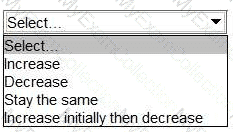
A company in country T is considering either exporting its product directly to customers in country P or establishing a manufacturing subsidiary in country P.
The corporate tax rate in country T is 20% and 25% tax depreciation allowances are available
Which TIIRCC of the following would be considered advantages of establishing a subsidiary in country T?
A company has announced a rights issue of 1 new share for every 4 existing shares.Â
Â
Relevant data:
   • The current market price per share is $10.00.
   • Rights are to be issued at a 20% discount to the current price.
   • The rate of return on the new funds raised is expected to be 10%.
   • The rate of return on existing funds is 5%.
What is the yield-adjusted theoretical ex-rights price?
Â
Give your answer to two decimal places.
Â
$Â ? Â
A company's latest accounts show profit after tax of $20.0 million, after deducting interest of $5.0 million. The company expects earnings to grow at 5% per annum indefinitely.Â
Â
The company has estimated its cost of equity at 12%, which is included in the company WACC of 10%.
Â
Assuming that profit after tax is equivalent to cash flows, what is the value of the equity capital?
Â
Give your answer to the nearest $ million.
Â
$ Â ? Â millionÂ
Company A is based in country A with the AS as its functional currency. It expects to receive BS20 million from Company B in settlement of an export invoice.
The current exchange rate is A$1 =B$2 and the daily standard deviation of this exchange rate = 0 5%
What is the one-day 95% VaR in AS?
The primary objective of a public sector entity is to ensure value for money is generated.
Value for money is defined as performing an activity so as to simultaneously achieve economy, efficiency and effectiveness
Efficiency is defined as:
Company ABC is planning to bid for company DDD, an unlisted company in an unrelated industry sector to ABC.
Â
The directors of ABC are considering a number of different valuation methods for DDDÂ before making a bid.
Â
Which of the following is the MOST appropriate method for ABC to use to value DDD?
The Treasurer of Z intends to use interest rate options to set an interest rate cap on Z’s borrowings.
Which of the following statement is correct?
A company proposes to value itself based on the net present value of estimated future cash flows.
Â
Relevant data:
   • The cash flow for the next three years is expected to be £100 million each year
   • The cash flow after year 3 will grow at 2% to perpetuity
   • The cost of capital is 12%
The value of the company to the nearest $ million is:
A government is currently considering the privatisation of the national airline. The shares are to be offered to the public via a fixed price Initial Public Offering (IPO).
Which THREE of the following statements are correct?
On 31 October 20X3:
   • A company expected to agree a foreign currency transaction in January 20X4 for settlement on 31 March 20X4. Â
   • The company hedged the currency risk using a forward contract at nil cost for settlement on 31 March 20X4.
   • The transaction was correctly treated as a cash flow hedge in accordance with IAS 39 Financial Instruments: Recognition and Measurement.
On 31 December 20X3, the financial year end, the fair value of the forward contract was $10,000 (asset).
Â
How should the increase in the fair value of the forward contract be treated within the financial statements for the year ended 31 December 20X3?
Company AAB is located in country A whose currency is the AS It has a subsidiary, BBA, located m country B that has the BS as its currency AAB has asked BBA to pay BS40 million surplus funds to AAB to assist with a planned new capital investment in country A The exchange rate today is AS1 = BS3
Tax regimes
• Company BBA pays withholding tax of 25% on all cash remitted to the parent company
• Company AAB pays tax of 10% on at cash received from its subsidiary
How much will company AAB have available for investment after receiving the surplus funds from BBA?
Company A has made an offer to acquire Company Z. Â
Both companies are quoted and their current market share prices are:
   • Company A - $4
   • Company Z - $5
Shareholders in company Z have been given three alternative offers:
   • Cash of $5.50 per share
   • Share for share exchange on the basis of 3 for 2
   • 10.5% long dated bond for every 20 shares
The bond is has a nominal value of $100 and the expected yield on bonds of similar risk is 10%.
Â
You are advising a Company Z shareholder on the three offers.
She requires a 15% premium if she is to accept the offer.Â
Â
In providing your advice, which of the following statements is correct?
A company is currently all-equity financed with a cost of equity of 8%.Â
It plans to raise debt with a pre-tax cost of 4% in order to buy back equity shares.
After the buy-back, the debt-to-equity ratio at market values will be 1 to 2.
The corporate income tax rate is 30%.
Â
Which of the following represents the company's cost of equity after the buy-back according to Modigliani and Miller's Theory of Capital Structure with taxes?
PPP's home currency is the PS. An overseas customer is due to make a payment of A$5,000,000 to PPP in 3 months. The present spot rate is 1PS = 5A$. P can obtain an interest rate of 4% per year on P$ deposits and 6% per year on AS deposits.
Forecast the value of the customer's payment to PPP, in PS, when the payment is made in 3 months' time.
Give your answer to the nearest thousand P$.

Which TWO of the following situations offer arbitrage opportunities?
A)

B)

C)

D)

A profit-seeking company intends to acquire another company for a variety of reasons, primarily to enhance shareholder wealth.
Which THREE of the following offer the greatest potential for enhancing shareholder wealth?
A wholly equity financed company has the following objectives:
1. Increase in profit before interest and tax by at least 10% per year.
2. Maintain a dividend payout ratio of 40% of earnings per year.
Â
Relevant data:
   • There are 2 million shares in issue.
   • Profit before interest and tax in the last financial year was $4 million.
   • The corporate income tax rate is 20%.
At the beginning of the current financial year, the company raised long term debt of $2 million at 5% interest each year.Â
Â
Calculate the dividend per share that will be announced this year assuming the company achieves its objective of increasing profit before interest and tax by 10%.
AÂ is a listed company. Its shares trade on a stock market exhibiting semi-strong form efficiency.
Â
Which of the following is most likely to increase the wealth of A's shareholders?
Company A is proposing a rights issue to finance a new investment. Its current debt to equity ratio is 10%.
Â
Which TWO of the following statements are true?
Company A is planning to acquire Company B.
Â
Company A's managers think they can improve the performance of Company B to the extent that its own P/E ratio should be applied to Company B's earnings.
Â
Relevant Data:
  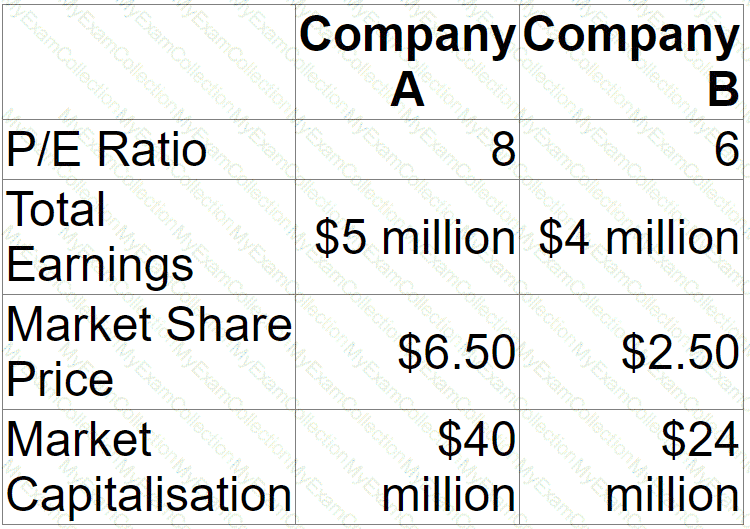
Â
What is the expected synergy if the acquisition goes ahead?Â
Â
Give your answer to the nearest $ million.
 Â
$Â ? Â million
Company Z wishes to borrow $50 million for 10 years at a fixed rate of interest.
Â
Two alternative approaches are being considered:
   A. Issue a 10 year bond at a fixed rate of 6%, or
   B. Borrow from the bank at Libor +2.5% for a 10 year period and simultaneously enter into a 10 year interest rate swap.
Â
Current 10 year swap rates against Libor are 4.0% - 4.2%.
Â
What is the difference in the net interest cost between the two alternative approaches?
A company has a cash surplus which it wishes to distribute to shareholders by a share repurchase rather than paying a special dividend.
Â
Which THREE of the following statements are correct?
A company has convertible bonds in issue.
The following debt is apply (31 December 20X0):
• Conversion ratio- 20 shares for each $130 bond.
• Current share price - $4 50
• Expected annual growth in share price - 5%
Advise the bond Holder at which date the convers on would be worthwhile?
Company AB was established 6 years ago by two individuals who each own 50% of the shares.
Each individual heads a separate division within the company, which now has annual turnover of GBP10 million and employs 40 people.
Some of the employees are very highly paid as they are important contributors to the company's profitability.
The owners of the company wish to realise the full value of their investment within the next 12 months.
Â
Which TWO of the following options are most likely to be acceptable exit strategies to the two owners of the company?
The shares of a company in a high technology industry have been listed on a stock exchange for 10 years. During this period, it has paid no dividends but invested all retained earnings in growth. The company is now entering a period of relatively stable growth and the directors are considering beginning to pay dividends They are reviewing the following suggestions made by members of the board:
• Pay cash dividends linked to growth in earnings
• Use a residual theory approach to establish cash dividends
• Issue scrip dividends (shares instead of cash)
• Continue to pay no dividends as dividends are irrelevant to the value of the company
Which THREE of the following are correct statements for the directors to take into consideration when making a decision about future dividend policy?
A listed company in a high technology industry has decided to value its intellectual capital using the Calculated Intangible Value method (CIV).
Â
Relevant data for the company:
   • Pays corporate income tax at 30%
   • Cost of equity is 9%, pre-tax cost of debt is 7% and the WACC is 8%
   • The value spread has been calculated as $26 million
Calculate the CIV for the company.
Company Z has identified four potential acquisition targets: companies A, B. C and D.
Company Z has a current equity market value of S590 million.
The price it would have to pay for the equity of each company is as follows:

Only one of the target companies can be acquired and the consideration will be paid in cash.
The following estimations of the new combined value of Company Z have been prepared for each acquisition before deduction of the cash consideration:

Ignoring any premium paid on acquisition, which acquisition should the directors pursue?
Companies L. M N and O:
• are based in a country that uses the RS as its currency
• have an objective to grow operating profit year on year
• have the same total levels of revenue and cost
• trade with companies or individuals in the United States. All import and export trade with companies or individuals in the United States is priced in US$.
Typical import/export trade for each company in a year are as follows:

Which company's growth objective is most sensitive to a movement in the USS / RS exchange rate?
A company plans a four-year project which will be financed by either an operating lease or a bank loan.
Lease details:
   • Four year lease contract.
   • Annual lease rentals of $45,000, paid in advance on the 1st day of the year.
Other information:
   • The interest rate payable on the bank borrowing is 10%.
   • The capital cost of the project is $200,000 which would have to be paid at the beginning of the first year.
   • A salvage or residual value of $100,000 is estimated at the end of the project's life.
   • Purchased assets attract straight line tax depreciation allowances.Â
   • Corporate income tax is 20% and is payable at the end of the year following the year to which it relates.
A lease-or-buy appraisal is shown below:
  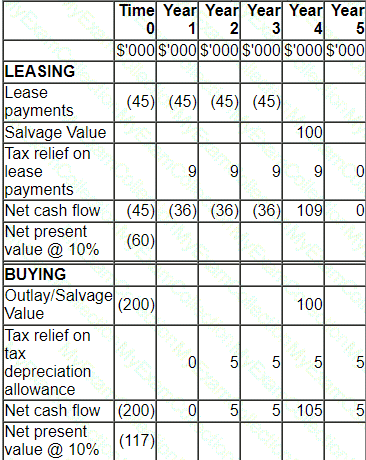
Â
Which THREE of the following items are errors within the appraisal?Â
Which THREE of the following prevent the Purchasing Power Parity Model from operating effectively in practice?
Which of the following statements are true with regard to interest rate swaps?
Select ALL that apply.
Companies A, B, C and D:
   • are based in a country that uses the K$ as its currency. Â
   • have an objective to grow operating profit year on year.
   • have the same total levels of revenue and cost.
   • trade with companies or individuals in the eurozone.  All import and export trade with companies or individuals in the eurozone is priced in EUR. Â
Typical import/export trade for each company in a year are as follows:
  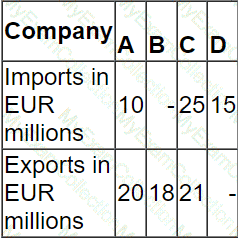
 Which company's growth objective is most sensitive to a movement in the EUR/K$ exchange rate?
A company is concerned that a high proportion of its debt portfolio consists of variable rate finance with an interest rate of LIBOR ' 1 .0%.
It is considering using an interest rate swap to reduce interest rate risk out is concerned about additional finance cost this might create.
A bank has quoted swap rates of 3% 3.5% against LIBOR.
A bank has quoted swap rates of 3% 3.5% against LIBOR.
Is an interest rate swap likely to be beneficial to the company at current LIBOR rates?
Which of the following explains an aim of integrated reporting in accordance with The International
ART manufactures traditional scooters. It has an equity beta of 1.4 and is financed entirely by equity. It plans to continue to be all-equity financed in future.
It is considering producing a range of electric scooters
GGG is a comparable quoted electric scooter manufacturer GGG has an equity beta of 2 4 reflecting its high level of gearing (the ratio of debt to equity is VI using market values).
The risk-free rate is 5%, and the market premium is 6%. The rate of corporation tax is 20%
What is the recommended discount rate that ART should use to assess the project to manufacture electric scooters?

H Company has a fixed rate load at 10.0%, but wishes to swap to variable. It can borrow at LIBOR 8%.
The bank is currently quoting swap rates of 3.1% (bid) and 3.5% (ask).
What net rate will HHH Company pay if it enters into the swap?
A listed company with a growing share price plans to finance a four-year research project with debt.Â
The main criterion for the finance is to minimise the annual cashflow payments on the debt.
The research will be sold at the end of the project.
Â
Which of the following would be the most suitable financing method for the company?
Â
A company plans to raise $12 million to finance an expansion project using a rights issue.
Relevant data:
• Shares will be offered at a 20% discount to the present market price of $15.00 per share.
• There are currently 2 million shares in issue.
• The project is forecast to yield a positive NPV of $6 million.
What is the yield-adjusted Theoretical Ex-Rights Price following the announcement of the rights issue?
A company is in the process of issuing a 10 year $100 million bond and is considering using an interest rate swap to change the interest profile on some or all of the $100 million new finance.
Â
The company has a target fixed versus floating rate debt profile of 1:1. Before issuing the bond its debt profile was as follows:
 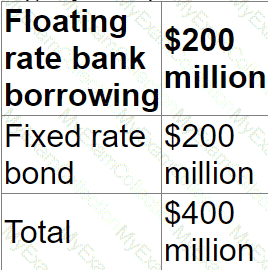
Â
Â
Which of the following is the most appropriate interest rate swap structure for the company?Â
DFG is a successful company and its shares are listed on a recognised stock exchange. The company's gearing ratio is currently in line with the industry average and the directors of DFG do not want to increase the company's financial risk. The company does not carry a large cash balance and its shareholders are not expected to be willing to support a rights issue at this time
LMB is a small services company owned and managed by a small board of directors who are going to retire within the next year
DFG wishes to purchase LMB and has approached LMB's owners, who are broadly open to the proposal, to discuss the bid and the consideration to be offered by DFG. LMB's owners explain to DFG that they are also keen to defer any tax liabilities they would be subject to on receipt of the consideration.
Based on the information provided, which of the following types of consideration would be most suitable to finance the acquisition?
WW is a quoted manufacturing company. The Finance Director has addressed the shareholders during WW's annual general meeting-She has told the shareholders that WW raised equity during the year and used the funds to repay a large loan that was maturing, thereby reducing WW's gearing ratio
At the conclusion of the Finance Director's speech one of the shareholders complained that it had been foolish for WW to have used equity to repay debt The shareholder argued that the Modigliani and Miller model (with tax) offers proof that debt is cheaper than equity when companies pay tax on their profits.
Which THREE arguments could the Finance Director have used in response to the shareholder?
Company A plans to acquire a minority stake in Company B.
The last available share price for Company B was $0.60. Â
Â
Relevant data about Company B is as follows:
   • A dividend per share of $0.08 has just been paid
   • Dividend growth is expected to be 2%Â
   • Earnings growth is expected to be 4%
   • The cost of equity is 15%
   • The weighted average cost of capital is 13%
Using the dividend growth model, what would be the expected change in share price?
A company's dividend policy is to pay out 50% of its earnings.
Its most recent earnings per share was $0.50, and it has just paid a dividend per share of $0.25.
Currently, dividends are forecast to grow at 2% each year in perpetuity and the cost of equity is 10.5%.
Â
In order to grow its earnings and dividends, the company is considering undertaking a new investment funded entirely by debt finance. If the investment is undertaken:
   • Its cost of equity will immediately increase to 12% due to the increased finance risk.
   • Its earnings and dividends will immediately commence growing at 4% each year in perpetuity.
Which of the following is the expected percentage change in the share price if the new investment is undertaken?
When valuing an unlisted company, a P/E ratio for a similar listed company may be used but adjustments to the P/E ratio may be necessary.
Â
Which THREE of the following factors would justify a reduction in the proxy p/e ratio before use?Â
The International Integrated Reporting Council (IIRC) was formed in August 2010 and brings together a cross-section of representatives from a wide variety of business sectors.
Â
The primary purpose of the IIRC's framework is to help enable an organsation to communicate how it:
A listed entertainment and media company produces and distributes films globally. The company invests heavily in intellectual property in order to create the scope for future film projects. The company has five separate distribution companies, each managed as a separate business unit The company is seeking to sell one of its business units in a management buy-out (MBO) to enable it to raise finance for proposed new investments
The business unit managers have been in discussions with a bank and venture capitalists regarding the financing for the MBO The venture capitalists are only prepared to invest a mixture of debt and equity and have suggested the following:

The venture capitalists have stated that they expect a minimum return on their equity investment of 3Q°/o a year on a compound basis over the first 5 years of the MBO No dividends will be paid during this period.
Advise the MBO team of the total amount due to the venture capitalist over the 5-year period to satisfy their total minimum return?
Company A needs to raise AS500 mi lion to invest in a new project and is considering using a pub ic issue of bonds to finance the investment.
Which THREE of the following statements-relating to this bond issue are true?
Which THREE of the following statements about stock market listings are correct?
Company E is a listed company. Its directors are valuing a smaller listed company, Company F, as a possible acquisition.
The two companies operate in the same markets and have the same business risk.
Relevant data on the two companies is as follows:
  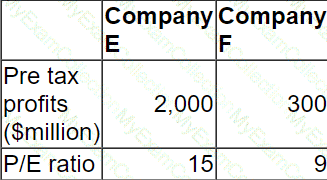
Both companies are wholly equity financed and both pay corporate tax at 30%.
The directors of Company E believe they can "bootstrap" Company F's earnings to improve performance.
Calculate the maximum price that Company E should offer to Company F's shareholders to acquire the company.
Â
Give your answer to the nearest $million.
Â
A listed company is financed by debt and equity.
If it increases the proportion of debt in its capital structure it would be in danger of breaching a debt covenant imposed by one of its lenders.
Â
The following data is relevant:
 Â
 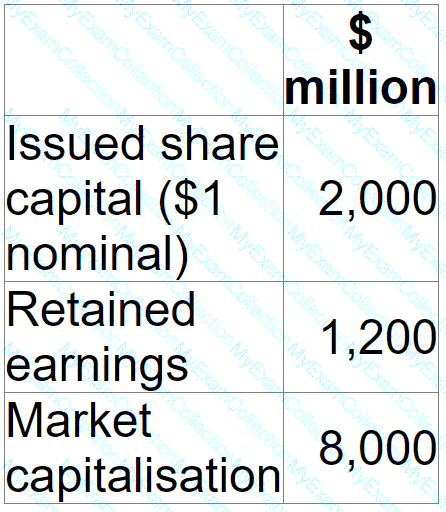
The company now requires $800 million additional funding for a major expansion programme.Â
Â
Which of the following is the most appropriate as a source of finance for this expansion programme?
A listed company plans to raise $350 million to finance a major expansion programme.
The cash flow projections for the programme are subject to considerable variability.
Brief details of the programme have been public knowledge for a few weeks.
The directors are considering two financing options, either a rights issue at a 20% discount to current share price or a long term bond.
Â
The following data is relevant:
  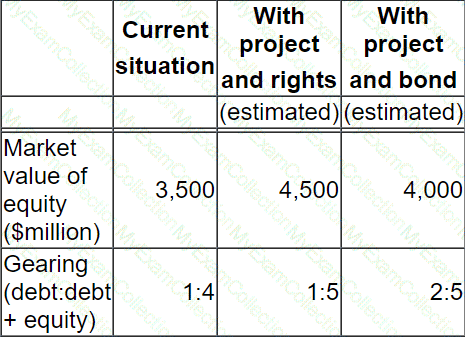
The company's share price has fallen by 5% over the past 3 months compared with a fall in the market of 3% over the same period.
The directors favour the bond option.
However, the Chief Accountant has provided arguments for a rights issue.
Â
Which TWO of the following arguments in favour of a right issue are correct?
A company has identified potential profitable investments that would require a total of S50 million capital expenditure over the next two years The following information is relevant.
• The company has 100 million shares in issue and has a market capitalisation of S500 million
• It has a target debt to equity ratio of 40% based on market values This ratio is currently 30%
• Earnings for the current year are expected to be S1 00 million
• Its last dividend payment was $1 per share One of the company's objectives is to increase dividends by at least 10% each year
• The company has no cash reserves
Which of the following is the most suitable method of financing to meet the company's requirements?
A company wishes to raise new finance using a rights issue to invest in a new project offering an IRR of 10%Â
Â
The following data applies:
   • There are currently 1 million shares in issue at a current market value of $4 each.
   • The terms of the rights issue will be $3.50 for 1 new share for 5 existing shares.
   • The company's WACC is currently 8%.
 What is the yield-adjusted theoretical ex-rights price (TERP)?
Â
Give your answer to 2 decimal places.
Â
$ Â ? Â
If a company's bonds are currently yielding 8% in the marketplace, why would the entity's cost of debt be lower than this?
Company T has 1,000 million shares in issue with a current share price of $10 each.
Company V has 300 million shares in issue with a current share price of $5 each.
Company T is considering acquiring Company V.
Total synergy gains of $100 million have been estimated.
The purchase of Company V's shares would be by cash at a 10% premium above the current share price.
Â
In seeking approval for the acquisition, the likely reaction from T's shareholders will be:
Company GDD plans to acquire Company HGG, an unlisted company which has been in business for 3 years.
Company HGG has incurred losses in its first 3 years but is expected to become highly profitable in the near future
There are no listed companies in the country operating in the same business field as Company HGG The future success of Company HGG's business and hence the future growth rate in earnings and dividends is difficult to determine
Company GDD is assessing the validity of using the dividend growth method to value Company HGG
Which THREE of the following are weaknesses of using the dividend growth model to value an unlisted company such as Company HGG?
Company H is considering the valuation of an unlisted company which it hopes to acquire.
It has obtained the target company's financial statements.
Company H has been advised that the book value of net assets as shown in the financial statements of the target company does not provide a reliable indicator of their true value.
Â
Advise the Board of Directors which of the following THREE statements are disadvantages of the net asset basis of valuation?
An unlisted company wishes to obtain an estimated value for its shares in anticipation of a private sale of a large parcel of shares.
Â
Relevant data for the unlisted company:
   • It has a residual dividend policy.Â
   • It has earnings that are highly sensitive to underlying economic conditions.
   • It is a small business in a large industry where there are listed companies but there are none with a similar capital structure.Â
Â
The company intends to base valuations on the cost of equity of a proxy company after adjusting for any differences in capital structure where appropriate.
Â
Which of the following methods is likely to give the most accurate equity value for this unlisted company?
Company M is a listed company in a highly technical service industry.
The directors are considering making a cash offer for the shares in Company Q, an unquoted company in the same industry.
Â
Relevant data about Company Q:
   • The company has seen consistent growth in earnings each year since it was founded 10 years ago.
   • It has relatively few non-current assets.
   • Many of the employees are leading experts in their field. A recent exercise suggested that the value of the company's human capital exceeded the value of its tangible assets.
The directors and major shareholders of Company Q have indicated willingness to sell the company.
Before negotiations become too advanced, the directors of Company M are considering the benefits to their company that would follow the acquisition.
Â
Which THREE of the following are the most likely benefits of the acquisition to Company M's shareholders?
The Board of Directors of a listed company is considering the company's dividend/retentions policy.
The inflation rate in the economy is currently high and is expected to remain so for the foreseeable future.
The board are unsure what impact the high level of inflation might have on the dividend policy.
Â
Which THREE of the following statements are true? Â
Company A has just announced a takeover bid for Company B. The two companies are large companies in the same industry_ The bid is considered to be hostile.
Company B's Board of Directors intends to try to prevent the takeover as they do not consider it to be in the best interests of shareholders
Which THREE of the following are considered to be legitimate post-offer defences?
Company W has received an unwelcome takeover bid from Company B. The offer is a share exchange of 3 shares in Company B for 5 shares in Company W or a cash alternative of $5.70 for each Company W share.
Company B is approximately twice the size of Company W based on market capitalisation. Although the two companies have some common business interested the main aim of the bid is diversification for Company B.
Company W has substantial cash balances which the directors were planning to use to fund an acquisition. These plans have not been announced to the market.
The following share price information is relevant.

Which of the following would be the most appropriate action by Company W's directors following receipt of this hostile bid?
RST wishes to raise at least $40 million of new equity by issuing up to 10 million new equity shares at a minimum price of $3.00 under an offer for sale by tender. It receives the following tender offers:

What is the maximum amount that RST can raise by this share issue?
(Give your answer to the nearest $ million).

On 1 January 20X1, a company had:
• Cost of equity of 10 0%.
• Cost of debt of 5.0%
• Debt of $100Mmilion
• 100 million $1 shares trading at $4.00 each.
On 1 February 20X1:
• The company's share police fell to $3.00.
• Debt and the cost of debt remained unchanged
The company does not pay tax.
Under Modigliani and Miller's theory without lax. what is the best estimate of the movement in the cost of equity as a result of the fall in ne share price?
A geared and profitable company is evaluating the best method of financing the purchase of new machinery. It is considering either buying the machinery outright, financed by a secured bank borrowing and selling the machinery at the end of a fixed period of time or obtain the machinery under a lease for the same period of time.
Which is the correct discount rate to use when discounting the incremental cash flows of the lease against those of the buy and borrow alternative?
A company is based in Country Y whose functional currency is YS. It has an investment in Country Z whose functional currency is ZS This year the company expects to generate ZS20 million profit after tax.
Tax Regime
• Corporate income tax rate in Country Y is 60%
• Corporate income tax rate in Country Z Is 30%
• Full double tax relief is available
Assume an exchange rate of YS1 = ZS5
What is the expected profit after tax in YS if the ZS profit is remitted to Country Y?
Company MB is in negotiations to acquire the entire share capital of Company BBA. Information about each company is as follows:

It is expected that Company BBA's profit before interest and tax will be $30 million in each of the two years after acquisition. Company AAB is considering how best to structure the offer Company AAB's discount factor and appropriate cost of equity for use in valuing Company BBA is 10%
Shareholders taxation implications should be ignored
Which of the following provides the shareholders of Company BBA with the highest offer price?
Which of the following statements about IFRS 7 Financial Instruments: Disclosures is true?
A company is currently all-equity financed with a cost of equity of 9%.
It plans to raise debt with a pre-tax cost of 3% in order to buy back equity shares.
After the buy-back, the debt-to-equity ratio at market values will be 1 to 2.
The corporate income tax rate is 25%.
Which of the following represents the company's cost of equity after the buy-back according to Modigliani and Miller's Theory of Capital Structure with taxes?
Company Y plans to diversify into an activity where Company X has an equity beta of 1.6, a debt beta of zero and gearing of 50% (debt/debt plus equity).
The risk-free rate of return is 5% and the market portfolio is expected to return 10%.
The rate of corporate income tax is 30%.
Â
What would be the risk-adjusted cost of equity if Company Y has 60% equity and 40% debt?
The directors of a financial services company need to calculate a valuation of their company’s equity in preparation for an upcoming initial Public Offering (IPO) of shares. At a recent board meeting they discussed the various methods of business valuation.
The Chief Executive suggested using a Price-earing (P./E) method of valuation, but the finance Director argued that a valuation based on forecast cash flows to equity would be more appropriate.
Which THREE of the following are advantages of valuation based on forecast cash flows to equity, compared to a valuating using a price earnings methods?
A listed company is planning a share repurchase.Â
Research into different offer prices has given the following data with regards acceptance by the shareholders at different prices:
 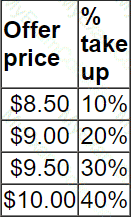
Â
Â
What price should be offered to shareholders if the retained earnings of the company are to remain unchanged?
An unlisted software development business is to be sold by its founders to a private equity house following the initial development of the software. The business has not yet made a profit but significant profits are expected for the next three years with only negligible profits thereafter. The business owns the freehold of the property from which it operates. However, it is the industry norm to lease property.
Which THREE of the following are limitations to the validity of using the Calculated Intangible Value (CIV) method for this business?
Which THREE of the following are the most likely exit routes that apply to a venture capitalist?
A company is considering taking out $10.000,000 of floating rate bank borrowings to finance a new project. The current rate available to the company on floating rate barrowings is 8%. The borrowings contain a covenant based on an interested cover of 5 times.
The project is expected to generate the following results:
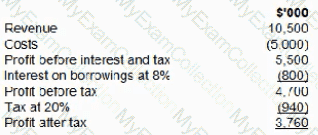
At what interest rate on the floating rate borrowings is the bank covenant first breached?
A venture capitalist invests in a company by means of buying:
   • 9 million shares for $2 a share and
   • 8% bonds with a nominal value of $2 million, repayable at par in 3 years' time.Â
The venture capitalist expects a return on the equity portion of the investment of at least 20% a year on a compound basis over the first 3 years of the investment.
Â
The company has 10 million shares in issue.
Â
What is the minimum total equity value for the company in 3 years' time required to satisify the venture capitalist's expected return?
Â
Give your answer to the nearest $ million.
Â
$Â Â million. Â Â
Â
A company based in Country A with the A$ as its functional currency requires A$500 million 20-year debt finance to finance a long-term investment The company has a high credit rating, but has not previously issued corporate bonds which are listed on the stock exchange Which THREE of the following are advantages of issuing 20 year bonds compared with simply borrowing for a 20 year period?


